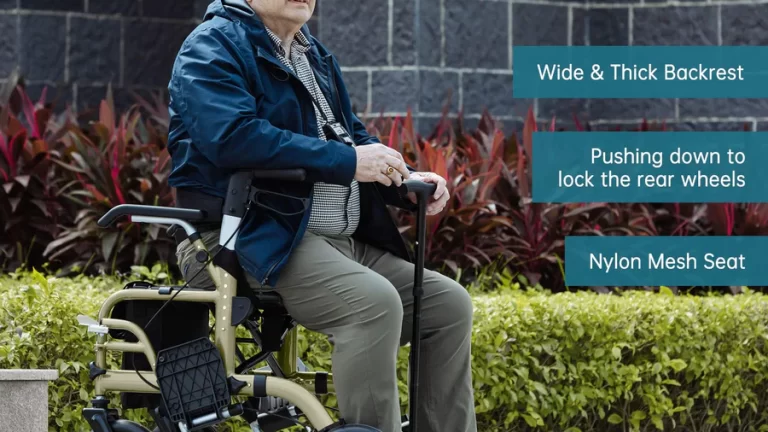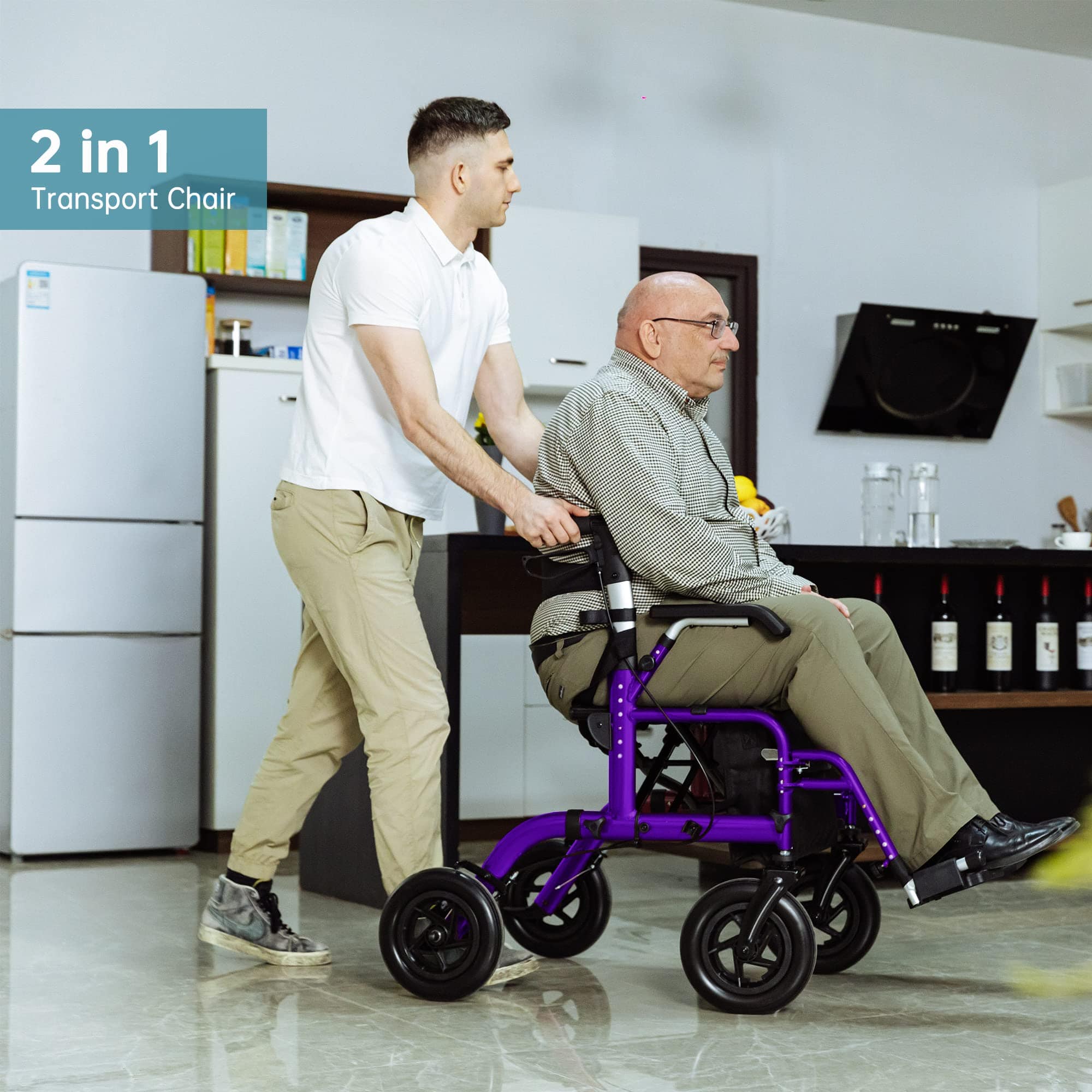A 2-in-1 rollator walker is a fantastic mobility aid that combines the functionality of both a walker and a wheelchair. But can it really be used as a wheelchair? Let’s break that down and take a deeper look at how these versatile devices work and whether they can serve as a wheelchair alternative.
How Does a 2-in-1 Rollator Walker Work?
A 2-in-1 rollator walker typically has four wheels and handles for stability, just like any traditional rolling walker. The key difference is that it includes a built-in seat, which provides an area to rest when the user is fatigued. To transform it into a wheelchair-like device, many of these walkers come with features like a seat belt and footrests that can be adjusted to offer more comfort and security, allowing the user to be pushed by a caregiver or family member.

Elenker 2 in 1 Rollator Walker when you walk
However, while a 2-in-1 rollator walker can provide some of the same functions as a wheelchair, it’s not exactly a direct substitute. It doesn’t have the same features as a full-fledged wheelchair, like a foot pedal for self-propulsion or a reclining function. Instead, it’s more of a hybrid, offering support for both walking and occasional sitting or being pushed.
Can You Use It as a Wheelchair?
In short, yes, a 2-in-1 rollator walker can be used like a wheelchair, but with some caveats. These walkers are mainly designed for seniors or those with limited mobility who need support while walking, but occasionally might need to sit down or be pushed. The wheels are often larger than those on regular walkers with seats, making it easier to roll over different surfaces, and the seat provides a place to rest when walking becomes too tiring.

Elenker 2 in 1 Rollator Walker when you sit
But here’s the thing: while the seat and design allow for a brief respite, a 2-in-1 rollator walker isn’t built for long periods of use as a wheelchair. The seating area may not be as cushioned or supportive as a proper wheelchair, and the footrests may not be as adjustable or comfortable as those on a typical wheelchair. Plus, a person using a rollator walker as a wheelchair would likely need someone else to push them, as the design doesn’t support self-propulsion the way a traditional wheelchair would.
Advantages of Using a 2-in-1 Rollator Walker
Versatility: The biggest perk is its versatility. With the 2-in-1 rollator walker, you get the best of both worlds. You can use it as a regular walker when you need to be mobile, and then switch to a resting mode when you get tired. This is especially useful for seniors or anyone who gets fatigued easily.
Ease of Movement: Walkers with wheels (like the 2-in-1 rollator walker) make it much easier to glide across smooth surfaces without needing to lift or drag the walker. It’s a lot more convenient than using traditional walkers for seniors who might struggle with lifting a non-wheeled walker.
Support and Comfort: The Elenker walker, for example, provides extra comfort by offering padded seats and armrests, making it easier for users to sit down and rest.
Independence: These walkers help maintain some level of independence, as users can still walk on their own with the support of the rolling walker. When needed, they can easily sit and relax without needing assistance.
Limitations of a 2-in-1 Rollator Walker
Not a Full Wheelchair Replacement: As mentioned, these walkers can’t replace a full wheelchair in every situation. They don’t provide the same level of comfort for long-term sitting or mobility over longer distances. For people who need to be in a wheelchair for extended periods, a traditional wheelchair is still the best option.
Limited Features: A traditional wheelchair has features like armrests, footrests that can be adjusted, and more comfortable seating for long-term use. In contrast, a rolling walker like the Elenker rollator or other walkers with seats is more focused on short-term mobility and resting, which means they lack some of the specialized features a wheelchair offers.
Not Ideal for Rough Terrain: While a 2-in-1 rollator walker can handle smooth indoor surfaces with ease, it’s not designed for rough, uneven terrain. If you plan to use it outdoors on uneven sidewalks or trails, you might encounter some difficulty.
When to Use a 2-in-1 Rollator Walker
A 2-in-1 rollator walker is perfect for individuals who need help with walking but don’t require a wheelchair full-time. They’re ideal for seniors who may get tired easily or people recovering from surgery who need some support. Walkers for seniors can make it easier to get around in the home, on trips to the store, or just out for a walk in the park. They provide enough support for mobility while also offering the option to rest if needed.
For those who occasionally need to be pushed, the 2-in-1 rollator walker can be helpful for short distances, especially if you don’t want to rely on a full wheelchair.
In conclusion, while a 2-in-1 rollator walker like the Elenker walker isn’t a full wheelchair replacement, it’s a great option for people who need a combination of walking support and occasional sitting. It’s versatile, comfortable, and allows for a greater level of independence compared to standard walkers with seats. However, for individuals who need long-term wheelchair assistance, it’s important to know that this hybrid walker doesn’t quite meet all the needs of a traditional wheelchair. It’s more of a flexible tool that works well for short-term use, helping people maintain mobility and providing a place to rest along the way.


